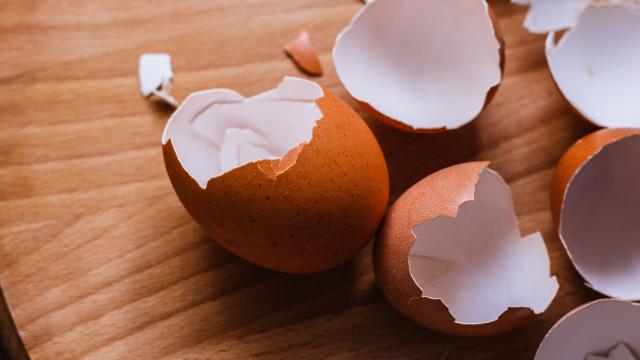It is true that one cannot make an omelet (or any egg dish) without breaking a few eggs. And even if you are the most careful egg cracker around, a bit of shell will make its way into the pan from time to time. This is not the disaster it may seem, but it is annoying.
Now, before you tell me to just “crack it on a flat surface,” I need you to know that I do not think that works as well as people say it does. I have cracked many an egg on many a flat surface, and on lots of hard edges, and I have concluded that, unless you are absolutely ramming your egg into that hard edge, one way isn’t particularly better than the other. Both can result in little bits of shell in the pan. But again, it’s not a big deal, because there are a few ways to get them out.
There are two popular “hacks” for removing these errant shell bits: using a bigger piece of the shell itself, and using a wet finger (which we have covered). The idea behind using the big piece of shell hinges on the theory that “like attracts like”; the small bit of shell will be attracted to the membrane still attached to the larger piece of shell. The wet finger method promises similar results, claiming the shell will “gravitate” to a wet finger.
To test this, I cracked a few eggs. I am a very practised egg cracker, so only one bit of shell ended up in the pan, even though I was being quite rough. I added a few more shell bits (about seven), just to give myself more data points. Then I tried to remove the shell shards. I attempted to remove half of them with the big piece of shell and half with a wet finger.
The little bits of shell did not gravitate to the larger piece of shell at all, but the jagged shell edge was kind of helpful as a scoop. It took at least two and sometimes as many as five attempts to fish out a little piece of the shell using this method. A wet finger proved more successful. Bits of shell were drawn to it, and I was able to remove them either on the first or second attempt.
So, the wet finger definitely won out as the superior shell removal method, but with one small caveat: Inserting one’s (wet) finger into a cold egg sitting in a cold pan is not dangerous, but things get a little more complicated when that pan is hot.
Seeing as I fry most of my eggs in screaming hot olive oil, inserting a finger into my frying pan is is rarely an option. Ah, but there is an elegant solution to this problem, too: just crack the egg in a teacup or ramekin first. Not only does that give you the opportunity to remove any little bits of shell, but the yolk is less likely to break, as you will be able to gently slide the egg into the hot pan, rather than cracking it directly into hot, violent oil.
And there you have it: no burned fingers, and a beautiful, shell-less fried egg.
This article has been updated since its original publish date.

Comments